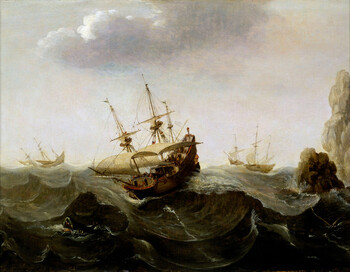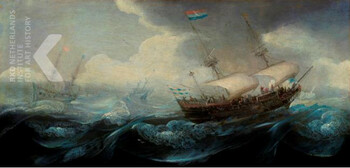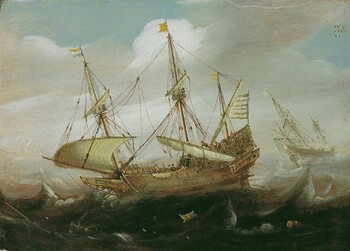Cornelis Verbeeck
Dutch ships in a rough sea
Oil on panel : 11,2 X 22,9 cm
Monogrammed “CVB”
Late 1620s
London, Greenwich, National Maritime Museum
This is a comparative item

Painting for Sale
Verbeeck, Cornelis Isaacz
"Dutch shipping near the beach"
In short
Holland was during the major part of the 17th century the rising star of Europe: a commercial, financial and colonial power that had freed itself from Spanish dominion. The Dutch East Indies Company, created already in 1602, was the world’s first mega-corporation and it possessed quasi-governmental powers. The huge Dutch herring fishing fleet and Holland’s numerous commercial ships generated so much money that it had to come to a conflict with that other power at sea, the British, during the third quarter of the 17th century.
Verbeeck takes an important place among the early Dutch marine painters, following closely its first generation (Hendrick Vroom, Cornelis van Wieringen, Aert Anthonisz., Jan Porcellis, Abraham de Verwer and Adam Willaerts).
About Cornelis Isaacz Verbeeck
Dutch painter
Probably born in Amsterdam (or Haarlem) circa 1590 – November 1637 or shortly after, Haarlem
His last name is sometimes spelt “Verbeecq”.
Painter of maritime subjects: a few large representations of historic events, but mostly small panels paintings with ships in stormy waters and more intimate beach scenes; a total of some 30 works are known, painted on panel or on copper.
Verbeeck became a member of the Painter’s Guild of Saint Luke in Haarlem in 1610 at the age of 20, just a few months after he got married there; his wife came from Amsterdam. The couple had three daughters and one or two sons.
It is not known whom he studied painting with. He was clearly influenced by Hendrick Vroom (1566 – 1640), the founder of Dutch marine painting who was also active in Haarlem. As to Verbeeck’s ships on rough seas these testify of his familiarity with Jan Porcellis’ storms; Porcellis (1583/85 – 1633), who had been a pupil of Vroom in Haarlem, returned here in 1622. In the 1620s both Vroom and Porcellis moved away from the colourful, narrative style influenced by the Flemish tradition to a tonal, atmospheric depiction of a more natural setting.
Verbeeck must have had a rather aggressive character: a considerable amount of legal records tell us how he was regularly involved in fights and stabbings, hence his surname “Smit” or “Smitge”, that refers to “smijten”, that is “to throw”. Despite this dubious reputation he did became a successful painter. In 1628, the local chronicler Samuel Ampzing (1590 – 1632) called Verbeeck in his poetic description of Haarlem (P. 372) ‘heel fraeij en net in schepen-malen’ (‘very fine and exquisite in ship painting’).
About our painting
The Twelve Years’ Truce ran from 1609 until 1621. It was a welcome period of peace during the Eighty Years’ War, the Dutch war of independence from Spanish dominion. Our high-sterned Dutch war vessel with open galleries at the centre is typical of the 1620s and early 1630s. During the Truce the Dutch admiralties had taken a substantial number of warships out of service. After 1621 a substantial shipbuilding programme started to replenish the resulting shortages.
Why should you buy this painting?
Because it is a nice example of early Dutch marine painting: an ode to this nation of seafarers.
Comparative paintings
Click photos for more details











